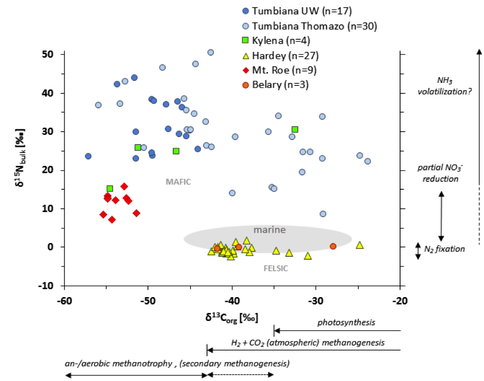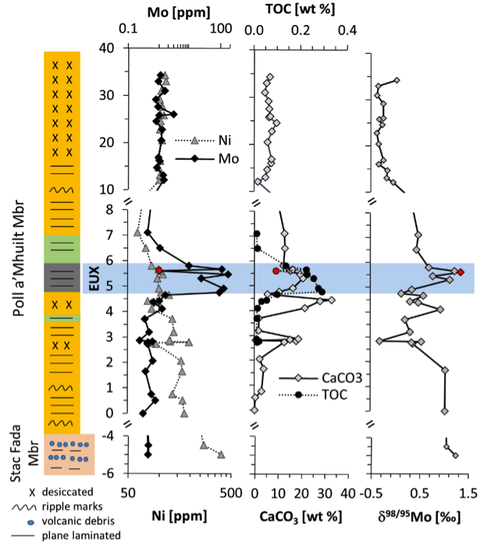2015 Annual Science Report
 VPL at University of Washington
Reporting | JAN 2015 – DEC 2015
VPL at University of Washington
Reporting | JAN 2015 – DEC 2015
Eva Stüeken NPP Postdoc Report
Project Summary
I study the non-marine sedimentary rock record to determine if lakes and rivers could have been important habitats for the early evolution of life on Earth. Our results suggest that the greater environmental diversity found in non-marine settings may enhance biological diversity. However, we cannot confirm previous conclusions that lakes were particularly suited for eukaryotic life. These findings may provide clues about potential biodiversity of other worlds that are characterized by smaller lake basins (e.g. early Mars) versus a global ocean (e.g. Europa).
Project Progress
My postdoctoral research project focuses on the role on non-marine environments in the early evolution of life. It is conceivable that lakes and rivers offered unique environmental niches that allowed specific metabolisms to evolve or radiate. I test this hypothesis through geochemical analyses of non-marine sedimentary deposits. The project is carried out in collaboration with NAI teams at the University of Washington and UC Riverside.
I selected three Precambrian and two Phanerozoic basins that have been described as lacustrine. These include parts of the lower Fortescue Group (Neoarchean; Western Australia), the Torridonian Supergroup (Mesoproterozoic; Scotland), the Callanna Group (Neoproterozoic; South Australia), the Newark Supergroup (Mesozoic; USA), and the Green River Formation (Eocene; USA). During the first year of my project, I collected samples in the field from the Torridonian Supergroup (fall 2014) and the Callanna Group (summer 2015), and I obtained drill core samples from the Newark and Fortescue Groups. Most of my analytical work so far has focused on the Torridonian and Fortescue samples and has led to two key conclusions.
First, in the Fortescue Group, which is convincingly lacustrine in parts, I found systematic correlations between nitrogen, carbon and molybdenum isotopes as well as bedrock lithology.
This patterns suggests a strong environmental control on microbial ecology that is not expressed in more homogenized marine basins, and it supports the idea that lacustrine habitats may have been favorable for certain organisms.
Second, my data from the lower Torridonian Supergroup reveal that this rock unit was most likely connected to the open ocean and thus not lacustrine. Previous studies argued, based on molybdenum abundances, sulfur isotopes and microfossils, that this lake basin was relatively more oxygenated and nutrient rich than the contemporaneous ocean, and that therefore lakes in general may have been preferable sites for eukaryotic evolution. My results instead suggest that we cannot use these rocks to characterize lacustrine habitats in the Mesoproterozoic. They were most likely deposited in an evaporitic playa lake that accumulated molybdenum and sulfur by evapo-concentration of seawater. Manuscripts describing these conclusions are in preparation.
Publications
-
Stueken, E. E., Buick, R., & Anbar, A. D. (2015). Selenium isotopes support free O2 in the latest Archean. Geology, 43(3), 259–262. doi:10.1130/g36218.1
-
Stüeken, E. E., Buick, R., & Schauer, A. J. (2015). Nitrogen isotope evidence for alkaline lakes on late Archean continents. Earth and Planetary Science Letters, 411, 1–10. doi:10.1016/j.epsl.2014.11.037
-
Stüeken, E. E., Buick, R., Bekker, A., Catling, D., Foriel, J., Guy, B. M., … Poulton, S. W. (2015). The evolution of the global selenium cycle: Secular trends in Se isotopes and abundances. Geochimica et Cosmochimica Acta, 162, 109–125. doi:10.1016/j.gca.2015.04.033
-
Stüeken, E. E., Buick, R., Guy, B. M., & Koehler, M. C. (2015). Isotopic evidence for biological nitrogen fixation by molybdenum-nitrogenase from 3.2 Gyr. Nature, 520(7549), 666–669. doi:10.1038/nature14180
-
Stüeken, E. E., Foriel, J., Buick, R., & Schoepfer, S. D. (2015). Selenium isotope ratios, redox changes and biological productivity across the end-Permian mass extinction. Chemical Geology, 410, 28–39. doi:10.1016/j.chemgeo.2015.05.021
-
PROJECT INVESTIGATORS:
-
PROJECT MEMBERS:
Rika Anderson
Collaborator
Dan Asael
Collaborator
John Baross
Collaborator
Eric Bellefroid
Collaborator
Roger Buick
Collaborator
Timothy Lyons
Collaborator
Noah Planavsky
Collaborator
Anthony Prave
Collaborator
-
RELATED OBJECTIVES:
Objective 4.1
Earth's early biosphere.
Objective 4.2
Production of complex life.
Objective 6.1
Effects of environmental changes on microbial ecosystems


